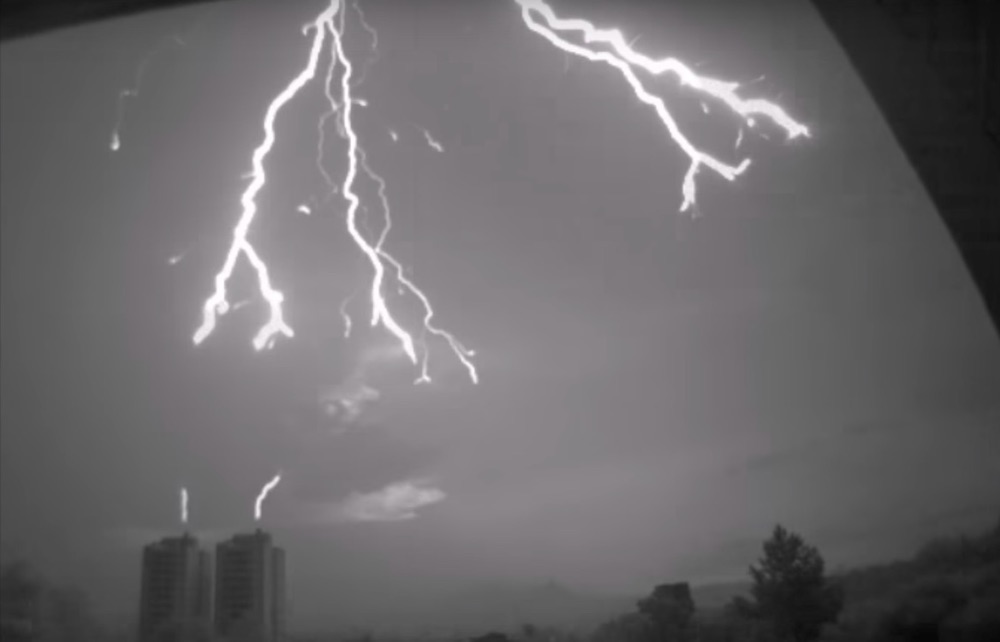See the 1st-Ever High-Speed Footage of Lightning Striking a Building
In addition to making for a dramatic show, the research could help improve lightning rods, a technology that hasn't changed in 200 years, the scientists said.
The video shows a tree of electrical discharges branching from a storm cloud and descending toward the ground. As the discharges near the ground, a weaker electrical column starts climbing from a lightning rod on a multistory building. When the rising discharge meets one of the downward leaders, as scientists call the sky-to-ground dischargers, a powerful flash blinds the camera's view. [Electric Earth: Stunning Images of Lightning]
"Since the time of Benjamin Franklin, no one has ever recorded a high-speed video footage of a lightning connection to a common building," said Marcelo Saba, a physicist at Brazil's National Institute for Space Research and leader of the new study, which was published online May 14 in the journal Geophysical Research Letters.
"It is very difficult to do. Cameras need to be very close to the structure chosen to be observed, and a long observation time is required to register one lightning strike to a particular structure," Saba told Live Science.
The physicists had to wait three years to capture four lightning strikes. The team used two black-and-white high-speed cameras similar to those used to record slow-motion imagery of sporting events, the scientists said. They installed the equipment permanently on a balcony belonging to an amateur storm watcher who lives about 650 feet (200 meters) away from the two buildings, on the outskirts of São Paolo seen in the video.
The two cameras — which could capture 70,000 and 40,000 frames per second, respectively — allowed the team to gain new insight into the dangerous natural phenomenon.
"Models and theories used to determine the zone of protection of a lightning rod exist, but they all suffer from the lack of field data," Saba said. "This footage allows us to see, for the first time in detail, how a lightning rod responds to the lightning, which is something that was missing."
Sign up for the Live Science daily newsletter now
Get the world’s most fascinating discoveries delivered straight to your inbox.
Saba thinks the team could use this technology to help lightning-rod makers design more efficient rods that would provide better protection for houses and infrastructure.
"If you install a lightning rod on top of your building and you have another building next to it, you want to know whether you need to install another one or not," Saba said. "It all depends on the protection area that one lightning rod provides. If the protection area is 10 meters [33 feet], you need another lightning rod. But if it's 500 meters [1,640 feet], you don't need it."

The high-speed footage allowed the researchers to calculate the speed of the electrical discharges. Most lightning happens in the direction from the cloud to the ground. Scientists call these discharges downward leaders. According to Saba, the downward leader travels at about 60 miles per second (100 km/s), while the discharge climbing from the rod (the upward leader) rises at about 0.03 miles per second (0.05 km/s).
According to the National Oceanic and Atmospheric Administration, upward leaders, or discharges that rise from the tops of buildings or mountains, are much more rare than downward leaders. However, Saba said most lightning-related injuries are, in fact, caused by these upward leaders. The upward leading discharges are dangerous even if they don't connect to the discharges that descend from the sky.
"These unconnected upward leaders can injure people because they carry a current of about 400 amperes," Saba said. "That's quite a lot. One light bulb consumes about 1 ampere, and this is 400 times as much."
In the video, the scientists captured one such unconnected upward leader rising from the top of the neighboring building. A video posted on YouTube earlier this year showed a news reporter suffering from an electrical shock from a lightning strike nearby. This effect is the result of unconnected rising electrical discharges, Saba said.
Original article on Live Science.










